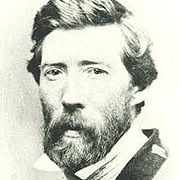

Hart was born in Paisley, Scotland, and was taken to America in early youth by his family. He was apprenticed to a carriage painter at Albany, New York, and his first artistic experience was in decorating the panels of coaches with landscapes. He also spent time as a portrait painter. He returned to Scotland, probably in the early or mid 1840s, where he studied for three years.
By the time he returned to America, Hart had shifted his energy to landscape painting. He exhibited his first work at the National Academy of Design in 1848, became a full member in 1858, and continued to show his paintings there regularly through the mid 1870s. He also exhibited at the Brooklyn Art Association and at major exhibitions around the country. Hart was a member of the American Watercolor Society, and was its president from 1870 to 1873.
Like most of the major landscape artists of the time, Hart settled in New York City and opened a studio in the Tenth Street Studio building in 1858. His mature landscape style embraced the mannerism of the late Hudson River School by emphasizing light and atmosphere. He became particularly adept at depicting angled sunlight and foreground shadow; the best examples of this are: Seashore Morning (1866) in the Metropolitan Museum of Art, New York; After the Storm (1860s) in the Museum of Fine Arts, Boston; The Last Gleam (1865) in the High Museum of Art in Atlanta, Georgia; Sunset in the Valley (1870) in a private collection, featured on pp. 82-83 of All That is Glorious Around Us: Paintings from the Hudson River School by John Driscoll; and A Quiet Nook (1885) in the Smithsonian American Art Museum, Washington D.C.
As strong as Hart’s technical abilities were, he is also known for his prolific and occasionally formulaic paintings of cows. Cattle were a popular motif in Hudson River School art, and nearly every artist included them in at least some of their landscapes as diminutive symbols of man’s harmonious relationship with nature. Some artists, including William and James Hart along with Thomas Bigelow Craig, made a specialty of cow portraits. These paintings, which were very popular with late 19th century American collectors, typically featured several cattle grazing or watering in the foreground or middle distance with the landscape playing a supporting role as a bucolic backdrop.
The Albany Institute of History and Art has in its collection over 400 sketches, water colors, and sketch books which were retained en masse from the artist’s studio after his death, by the family of the subsequent donor. Since each piece is signed, dated, and annoted with the location of its subject, many previously unsigned and unattributed paintings are now being associated with the artist. The museum is preparing an exhibition of this material.
Hart died at Mount Vernon, New York, on June 17, 1894.
www.thefullwiki.org